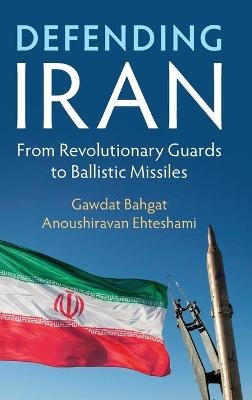
Defending Iran
Cambridge University Press (Verlag)
978-1-108-47678-2 (ISBN)
Since the 1979 revolution, the ruling establishment of Iran has developed and articulated a defense strategy reflective of the country's Iran-Iraq war experience and its international isolation. Its asymmetrical warfare doctrine, use of irregular forces in military campaigns, deployment of ballistic missiles, use of fast naval vessels to harass and confuse adversaries, and finally development of a sophisticated cyber warfare capability, are all features of this unique defense strategy. Based on a wide range of primary sources in Persian, Arabic and English, Gawdat Bahgat and Anoushiravan Ehteshami offer a detailed and authoritative analysis of Iran's defense strategy. Additionally, this book provides a comparative analysis of the Islamic Republic's capabilities in relation to Israel and Saudi Arabia, its main regional adversaries. Framing Tehran's threat perceptions following the revolution within a wider historical context, this book will facilitate further analytical reflections on the country's changing role in the region, and its relations further afield, with the United States, Europe, Russia and China.
Gawdat Bahgat is Professor of National Security in the Near East South Asia Center for Strategic Studies at the National Defense University. He is the author of twelve books including Energy Security in the Gulf (2015), Alternative Energy in the Middle East (2013), Energy Security (2011), International Political Economy (2010), Proliferation of Nuclear Weapons in the Middle East (2007), Israel and the Persian Gulf (2006) and American Oil Diplomacy (2003). He has appeared as a frequent contributor to media outlets including the BBC, CNN and Washington Post. Anoushiravan Ehteshami is Professor of International Relations in the School of Government and International Affairs at Durham University. The Nasser al-Mohammad al-Sabah Chair in International Relations and Director of the HH Sheikh Nasser al-Mohammad al-Sabah Programme in International Relations, Regional Politics and Security, he is, further, Director of the Institute for Middle Eastern & Islamic Studies (IMEIS) at Durham, a Fellow of University College Durham, a Fellow of the Academy of Social Sciences, and Fellow of the Royal Society of Arts. He is the co-author of publications including Islam, IS and the Fragmented State: The Challenges of Political Islam in the MENA Region (2021), How China is Changing the Middle East (2020), and author of Iran: Stuck in Transition (2017).
Preface; 1. Iran's Threat Perceptions; 2. Defense Institutions: Politics and Power; 3. Iran's Military-industrial Complex; 4. Structure and Make-up of Iran's Armed Forces; 5. Iran's Ballistic Missiles and Space Program; 6. Cyber Security: Iran and Its Neighbors; 7. Naval Forces; 8. Iran's Drone Capabilities; 9. Proxies and Partners; Conclusion: The Way Forward.
| Erscheinungsdatum | 13.09.2021 |
|---|---|
| Zusatzinfo | Worked examples or Exercises |
| Verlagsort | Cambridge |
| Sprache | englisch |
| Maße | 158 x 235 mm |
| Gewicht | 590 g |
| Themenwelt | Geisteswissenschaften ► Geschichte ► Regional- / Ländergeschichte |
| Sozialwissenschaften ► Politik / Verwaltung ► Europäische / Internationale Politik | |
| Sozialwissenschaften ► Politik / Verwaltung ► Staat / Verwaltung | |
| ISBN-10 | 1-108-47678-3 / 1108476783 |
| ISBN-13 | 978-1-108-47678-2 / 9781108476782 |
| Zustand | Neuware |
| Haben Sie eine Frage zum Produkt? |
aus dem Bereich


